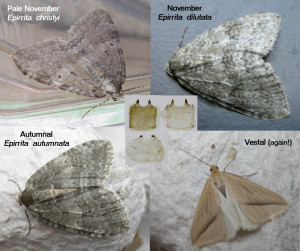A warm air-mass moved into southern England from the Azores area towards the end of October this year which brought better mothing for a time. Daytime temperatures at home peaked at 18.3C and several nights stayed over 10C. The best nights for me were on 25th and 28th when I took the opportunity to visit Captain’s Wood for autumn moths in addition to running my traps at home in Hollesley. Colder northerlies are now setting in to scatter the autumn colours off the trees.
Captain’s Wood provided a very different picture to my catches at home. In contrast to home there were no Black Rustics, in fact very few noctuids and no Epiphyas postvittana, yet lots of Feathered Thorn. I have however picked up a couple of single Feathered Thorn at home now. What delighted me the most at Captain’s Wood though, was that the first moth I spied on 25th was a clear example of the Pale November Moth. The first I have recorded since mothing in Suffolk. Others examples also turned up along with the Autumnal and November Moths. The Epirrita have been abundant at home this year too and I also managed to confirm one Pale November at home on the same date. Being such clearly marked examples at Captain’s Wood allows me to show the difference between them in the photos below. Primarily, as shown in Skinner, the main difference is in the median band. This is even width and fairly straight in E. christyi until it widens a little and bends proximally near the costa. The discal spot is clearly defined and well separate. The median band of the Autumnal moth widens centrally by virtue of it bulging between the veins distally and then continues wider as it bends towards the costa. The discal spot is usually clear and separate. The median band of E. dilutata is far from even, in particular being restricted just dorsal to the disc and is then much wider and irregular as it reaches the costa. The discal spot is seldom clearly separated. Where specimens do not show clear markings the thickening of the 8th sternite of the males can be used to separate the species but this is not easy on a live moth and the distinction is slight between christyi and dilutata.
Migrants have continued to turn up at home. Only Plutella xylostella was found at Captain’s Wood but this has reached zero at home now. Quite a few Udea ferrugalis in good condition, several Dark Sword-grass, two Silver Y, three Nomophila noctuella and one Vestal, which was a surprise. Used it to fill in the the Epirrita square (sorry!).
Also of interest at home so late in the season and in good condition have been, White Point, Feathered Ranunculus, Vine’s Rustic and an Evergestis forficalis. Still hoping for a Juniper Carpet but only Cypress Carpets being caught. Mustn’t let that hope result in a mis-identification next year!


I find that the Pale November moth is more typically found in woodland so would tie in with your sighting at Captain’s wood Raymond. Autumnal moth I find more on heaths and heathy woodland with Birch in Suffolk. Nice photos showing banded individuals of each moth.